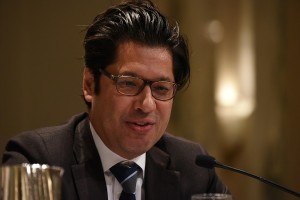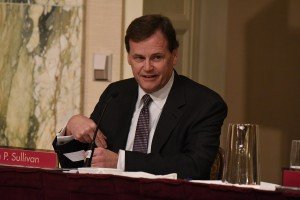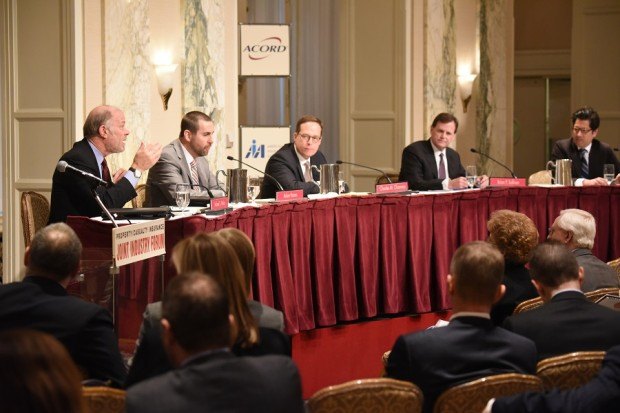Fill in the blank: Advertising is to the Internet as <Blank> is to the Internet of Things.
Until I attended the Property/Casualty Insurance Joint Industry Forum earlier this month, the blank-filler—”insurance”—didn’t leap to my mind.
Actually, I have been out of touch for a while, according to Hemant Shah, the chief executive officer of risk modeler RMS, who told insurers attending the insurance forum that the analogy first came to light back in 2014—at a technology forum called the Solid Conference. It was there that Tim O’Reilly, chief executive officer of O’Reilly Media and the Solid Conference’s organizer, said this:
You know the way that advertising turned out to be the native business model for the Internet? I think insurance is going to be the native business model for the Internet of Things.
Wow! How did I miss that?
This year’s insurance forum session focused on the ramifications of various types of changing technology to the industry, and panelists volleyed warnings of competitive threats and looming risks back and forth. Shah served up possibilities instead—and his memory of O’Reilly’s prediction stood out as the hands-down highlight of the discussion for me.
O’Reilly, Shah noted, coined the term Web 2.0. He is also said to have coined the term open source, another bold idea. This one about IoT seemed so full of promise for insurers hunting for avenues of growth that it prompted me to hunt down a video clip of that Solid conference. What else did he have to say about the ginormous opportunity he seemed to dangle in front of attentive participants in the insurance industry?
Here’s a link to that clip. Set your marker to about 12:45 minutes in:
https://www.youtube.com/watch?v=lAgJazKpH5k
O’Reilly did not elaborate much on his forecast beyond saying, “We’re going to see all kinds of startups that are monetized through various kinds of insurance or insurance savings.” He also mentioned the example of Climate Corporation, a company that provides farmers with weather data and agronomic modeling to boost yields and manage risk—but which started out selling weather insurance. “The more data allows things to become more predictable, it changes the dynamics of that entire industry,” he said.
Other commentators since have interpreted O’Reilly’s suggestion, focusing on the reams of data that connected devices throw off as they offer hypothetical paths for insurance to become the economic backbone of the Internet of Things—the world of autos, homes, factory warehouses and other formerly standalone objects now connecting to the Internet, and to each other. Some focus on telematics devices, sending data about individual driving behaviors to insurers, who can then use that data to incentivize better driving habits. One even speculated about health insurers locking the refrigerator doors of policyholders reaching for one too many pieces of fried chicken.
Shah thinks bigger, and at the Forum he seemed to take insurers to task for not being aggressive enough about seizing an opportunity—an opportunity that’s really rooted in the history of insurance. (Importantly, Shah also sounded some of the loudest alarms about risk accumulations that have to be understood in order to allow more aggressive insurer activity.)
“The amount of energy that goes into understanding how telematics and driverless cars and whatnot might significantly reduce a line of business—we need at least as much energy in talking about what aspects of the economy create new classes of exposure that are completely uninsured,” Shah said early on.
That comment came after dire predictions about how digitization, advanced analytics, accident avoidance systems and driverless cars could obviate the need for people working in personal lines—and the need for the personal auto insurance at all— from co-panelists Michael Pritula, director of the Global Insurance Practice of McKinsey & Company and Brian Sullivan, editor for Risk Information, Inc. Pritula and Sullivan counterbalanced those negative forecasts with a brief discussion of insurance opportunities related to the Sharing Economy.
Describing the Sharing Economy opportunities as “relatively modest” Shah challenged insurers “to think more aggressively.”
“I do continue to feel that there’s an asymmetry in these discussions. In the context of insurance, we spend a lot of time talking about the disruptive negative impact some of these new technologies can have on established lines of business. And the energy in the room is quite significant because there’s a lot at stake—a very large personal auto market.”

(Photo by Don Pollard)
“And on the margin, we have an interest in the new opportunities [that are] one or two orders of magnitude smaller than what we perceive [are] the disruptive opportunities…..
“You have to think what does an industry look like that is two- or three-times bigger covering essentially a highly connected increasingly digital economy where the concerns aren’t assets at risk. They’re systems at risk,” he said, urging a changed mindset.
“There’s significant opportunity to deploy an understanding of technology into product that adds value by creating a fundamentally new class of insurable products….Much more energy needs to be spent on that dialogue.”
Back to the Future
Although Shah annunciated the word “product” with particular clarity, the product opportunity he sees is really a “service” opportunity—one that he says brings the industry “back to the future.”
The early fire insurance products were largely about providing a service—to put out fires, he said. Today, the Internet of Things and sensor technology can create an active process for managing risk, he said. “You can perhaps see insurance products evolving back into performing the service of ensuring the productive use of the asset with some sort of warranty if something goes wrong,” as opposed to be principally being about coverage.
“The opportunities are very significant,” he said, suggesting that a sensor alerting the replacement of a $100 filter could avoid the loss of a million-dollar compressor and halt billions of dollars of productivity losses from a failed industrial process. Alluding to the discussion of vanishing personal auto insurance prospects in the coming years, he said the exposures are going to shift from personal lines to commercial lines. Now the opportunities are to provide coverage to the systems that operate networks of vehicles.”

(Photo by Don Pollard)
Sullivan noted the increasing need for modelers like Shah’s RMS in a world where losses rarely happen but they happen on a large scale when they do occur. For “the fender bender that happens a zillion times, you have 25 years to data [and] you can be very confident about how many fender benders next year. [But for] systems that go down in multiple houses causing water to overflow, it’s going to be much harder to price,” he observed, suggesting the need for “hurricane models for water losses from toilets overflowing.”
Pritula focused in on the sensor-based data in commercial facilities. “There is now a stream of data that is available to huge commercial lines underwriters,” he said. “Underwriting is going to be changing because this data is going to be available on a real-time basis, which will also drive more loss prevention activity.”
“We’re really moving rapidly away” from the old methods—”get the last 10 years of loss reports for that factory” to come up with a price of X. “What advanced analytics and IoT is doing to the connected world has the potential to be far more transformative in the commercial lines arena than personal,” Pritula said.

Risk Information, Inc.
(Photo by Don Pollard)
Shah commented on the magnitude of the data available from the Internet of Things, citing an estimate that 40 zettabytes of data will be annually created by the year 2020, mainly from IoT components. That’s only a few years away, he said.
Sullivan also weighed in on the speed of change, contrasting the time frames for widespread adoption of automonous vehicles—which he puts at the year 2040—with the time needed connect homes and factories.
“You can’t retrofit a 1997 Honda Accord to be a self-driving car. But when it comes to factories and homes, connecting them to the Internet of Things is completely easy and extremely inexpensive,” Sullivan said. “We can go to a world where the toasters are all connected in a five-year span. It could happen like that,” he said.
Related Articles:





















 How Insurers Can Avoid Post-Merger Technology Failure
How Insurers Can Avoid Post-Merger Technology Failure  Surge of Supercharged Hurricanes Prompt Call for Cat 6 Classification
Surge of Supercharged Hurricanes Prompt Call for Cat 6 Classification  Why ‘Good Enough’ Is Killing Insurance: The Hidden Cost of Satisficing
Why ‘Good Enough’ Is Killing Insurance: The Hidden Cost of Satisficing  Nearly Half of 100 Largest P/C Insurers Destroy Value: ACORD
Nearly Half of 100 Largest P/C Insurers Destroy Value: ACORD 








